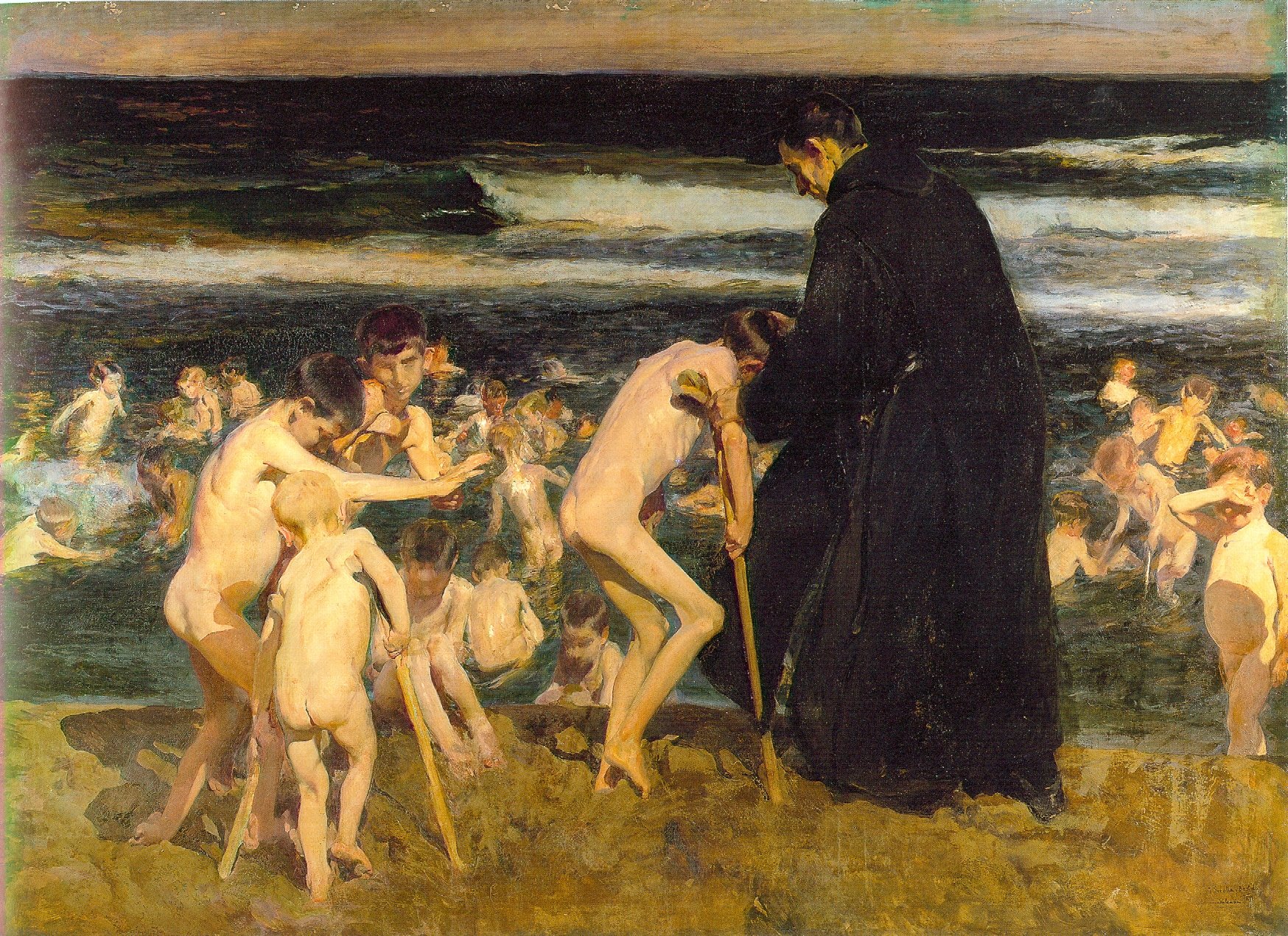 |
|
Triste Herencia (Sad Inheritance) by Joaquin Sorolla (1899)
|
In counterpoint to Joaquin Sorolla’smany light and luminous canvases of naked children playing on the beach, Triste Herencia (Sad Inheritance) is a dark painting of children in a dark sea. Examined carefully, the painting is a detailed catalogue of woes—blindness, club foot, leprosy, and above all, polio, which was just starting its reign of terror at the time this was painted.*
 |
|
Sorolla’s Chicos en la Playa (1910) is more typical of his beach children.
|
Dwarves have a long history as palace accessories to the European nobility, so it’s no surprise that they’ve been painted by many masters. Perhaps the most famous of these paintings is Diego Velázquez’s Las Meninas, which includes both an achondroplasticdwarf (Maria Barbola) imported from Germany and an Italian proportionate dwarf(Nicolas Pertusato), kicking the dog.
 |
|
The Jester Calabacillas, Bobo de Coria or Juan de Calabazas (1637-1639) by Diego Velázquez
|
Velázquez painted an entire lexicon of dwarfism, and his portraits are notable both for the respect he shows his subjects and for the honesty with which he portrays their condition. His portrait of Don Juan Calabazas is a highly sympathetic portrait of mental retardation. Calabazas was nicknamed “Calabacillas” or “Pumpkinhead,” a nickname we would find utterly objectionable today. Velázquez does not shrink from Don Juan’s disabilities, carefully documenting his subject’s symptoms, including his vacant smile, the frantic gesturing of his hands, his crouching posture. But in spite of that, Velázquez painted him with as much respect and affection as he ever did Philip IV or his family.
Compare this to the most well-known American painting of disability, Christina’s World, by Andrew Wyeth(1948). One would never crawl across a Maine hayfield naked, so Anna Christine Olson’s disability is masked to some degree by her clothing. But beyond that, the painting tells us nothing about her. It is a carefully constructed, beautiful composition focusing on the surface of the field and the elegant shapes of the buildings. (Both the buildings and the figure are substantially altered from their reality.)
Christina’s withered limbs are an addendum to a completely separate idea. They draw us into what otherwise would be “Triangular Composition: Girl in Pink Dress on a Grass Field.” Seen in its most cynical light, they’re there to sell the painting.
 |
|
Christina’s World, by Andrew Wyeth (1948) is a very American view of disability.
|
That’s not an indictment, of course; Wyeth is just treating disability the way the rest of America does. As the parent of four children, I know that schools offer the disability label as a ticket to purchase compassion from an otherwise inflexible system, and the pressure to buy into this system is overwhelming. All of this is a diminution to the truly disabled, many of whose withered limbs are hidden from us.
This being the season of the Compassionate Shepherd, I am reminded of his encounter with the Samaritan woman at the well, told in John 4:4-26.
The woman said to him, “Sir, give me this water so that I won’t get thirsty and have to keep coming here to draw water.”
He told her, “Go, call your husband and come back.”
“I have no husband,” she replied.
Jesus said to her, “You are right when you say you have no husband. The fact is, you have had five husbands, and the man you now have is not your husband. What you have just said is quite true.”
To our modern ears, that’s a pretty harsh exchange, but it was absolutely necessary that she acknowledge her reality before she could begin any process of renewal.
We moderns cannot be honest about the human condition because we are relativists; the only truth we understand as absolute is “don’t be judgmental.” But resolution requires honest assessment. Perhaps it is no surprise after all that Sorolla’s monk starts with the naked, brutal truth to help his poor charges. Perhaps it is no surprise that he is grim.
——
*I was shocked to read that polio epidemics were a 20th century scourge, although the disease itself has been known since antiquity. Before the 20th century, poor sanitation resulted in a constant exposure to the polio virus, which provided natural immunity from infancy. As sanitation improved in Europe, childhood exposure declined. The first localized epidemics occurred in Europe and the United States around 1900, the time Sorolla painted Triste Herencia.



